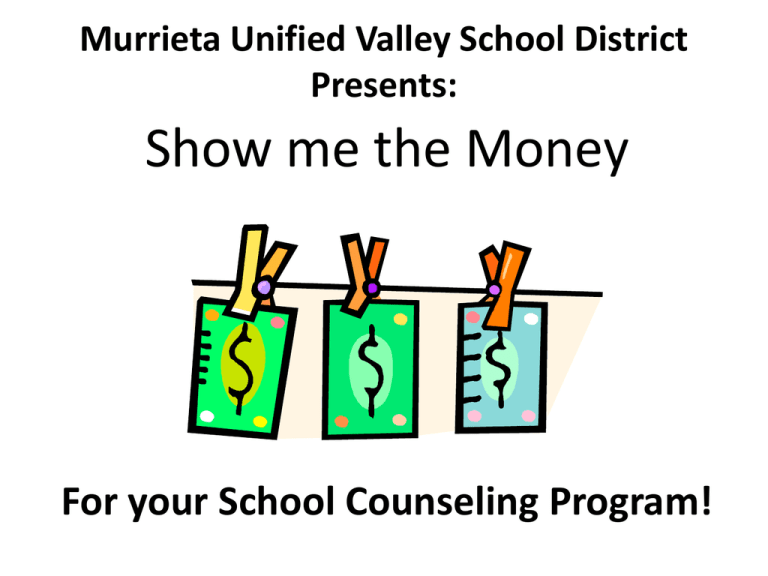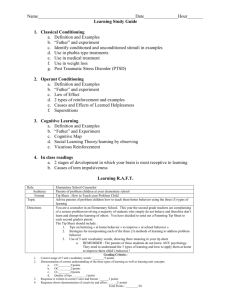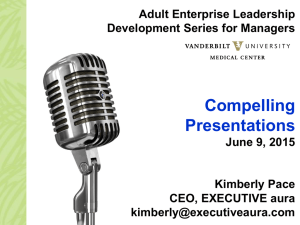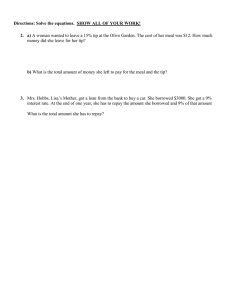Show me the Money For your School Counseling Program! Presents:
advertisement

Murrieta Unified Valley School District Presents: Show me the Money For your School Counseling Program! Goals of the Session: • • • • • • How to obtain ESSCP grant 15 plus tips for winning grants The importance of data and accountability 10 + Tips to maintain sustainability How multimedia can help! Answer your questions (if time!) Why Did We Write a Grant? • • • • Had NO elementary school counselors Principals wanted more help! Needed counselors! Looking for way to provide support Learned of the Federal grant: Elementary and Secondary School Counseling Demonstration grant – @1.2 million dollars over 3 years for 2 GRPA requirements – Purpose was to increase SC – Decrease violence referrals If We Can Do It You Can Too! • • • • We wrote a winning grant with no experience! Did well! (scores 98! & 99!) We have learned a lot and want to share We hope this session helps you to implement a successful grant! Let’s get started… Main Points of OUR Grant • Hire 3 Elementary School Counselors • Create a multi-tiered process for curriculum, referrals and intervention • Provide all of our 4/5th graders with universal prevention program • Provide intervention for students needing more • Provide crisis response services Tip #1 Start Early • Its more work than you think • Takes longer to get everything together than you can imagine • Stuff comes up in your day • People you need signatures from are not around • You really can’t close your door – people bother you • The woman you need budget stuff from is on maternity leave Tip #2 Familiarize yourself with RFA • Allow time to familiarize self with RFA • Get samples from other districts or all others who have won them (their names are on line) • Read through several times • Familiarize yourself with each area you have to write to • Make sure you FOLLOW formatting requirements Tip #3 Don’t be afraid to call USDE • • • • • They really will answer the phone They will answer questions They really do want you to get the grant They really do want you to spend the money They are not out to take it away – their job is to support successful implementation Tip #4 Assemble Team(s) We had two teams: • Administration team – Principals and assistant principals, D/O etc. to discuss site team – Met with each principal to ENSURE they would support if we obtained grant • Grant writing team – Teacher (50%) – School counselors – Director of Student Services Tip #5 Involve the Community • Involve community • Involve parents • Utilized anecdotal statements from them about bully issues on campuses Tip #6 Gather the Data you Need • Violence and Safety Data – Discipline Data – CHKS (in CA) or YRBS in most states – All states were required to collect this data if they have accepted Title IV funds (which is over, but they should still have data) • Academic data (better climate better achievement) so we looked at that too – Language Arts and Math Scores (CST’s) Tip #7 Be Realistic in Design • We had NO elementary school counselors before • Had over 9,000 students • Wanted to serve them all (with 3 counselors?) • Recommend 1 per school? • Focused energies with 4/5th graders only. • Could have picked 3 schools with greatest needs Tip #8 Involve Non Profits/Agencies • Involving non profits and community agencies can increase communication with outside and local providers • Better opportunities for outside referrals • Grants helps you create articulation for agreements for services • Will support you in future grant writing efforts Tip #9 Request letters early • • • • • • Ask for more than you need Make it easy for them Offer to write it Send a sample Give an early deadline Have a backup plan Tip #10 Ask Local Rep. to Write a Letter • Mary Bono Mack (Congresswoman 45th district) wrote ours • Once grant is submitted, get the number (post card #) • Then call or email and ask them to write a letter of endorsement for your grant • They will also be involved with promoting grant in the future • Great for public relations • And sometimes they all you to tell you WON! • Went to share results with her and what we did with the money so she’d support it again! Tip #11 – Use One Voice • • • • Do not break up sections with authors Needs consistent voice Needs to read in a flowing way – not choppy When done, ask someone to read that doesn’t know the grant – see if it makes sense to them (sometimes we don’t’ see holes) Tip #12 Use one Operating SYSTEM! • Switching from Mac to PC is a disaster • Multiple versions are a formatting nightmare! (Word 2003, Word 2007) – STICK with ONE! • Excel to PowerPoint for charts and graphs: use ONE mode Tip #13 - Use District Summaries • District must create summary reports yearls • Ask for a copy – saves time on demographics and district/community narratives • May find in District accountability report cards Tip #14: Keep Your Own Data File • Tear out local demographical info and keep handy • Local newspaper a good resource • Magazine articles • Anything to do with district data or local economic info Tip #15 Failure is a Future Opportunity • After you hear back (funded or not) remember to ASK for the rating sheets! • This is great feedback for the next time you write any grant Outcomes: We Had 8 Goals 1. Increase number of school counselors 2. Increase 4th and 5th grade Language Arts and Math proficiency 3. Decrease number of referrals suspensions 4. Students will display positive attitudes about school and teachers Objectives: Goal 5. Students are supported at home – parents actively participate 6. 5th grade students attendance rates improve 7. Homework completion and accuracy increase – (took this one out) 8. Elementary school students who need mental health services are identifies and connected to services Guidance Lesson Curriculum • • • • • Taight guidance lessons to >> When What Where Meaures impact with prepost Pre and Post Test Highlights • Students were asked pre-post test questions to determine what they gained from the lessons based on the following: • Attitudes: What they believed • Knowledge: What information they learned • Skills: How they could apply this information What do Students Learn? 100 90 80 70 60 50 40 30 20 10 0 89 86 87 79 71 Pre Post 2 What personal strengths are Difference between anger and violence What the "Golden Rule" is What did Students Learn? 100 90 80 Nice growth seen here 93 94 75 Students appear to know this prior to the lesson 70 60 50 40 Pre 37 Post 30 20 10 0 Identify the STAR method Identify one thing they could do if bullied (tell adult) “I believe there is an adult at school I can go to for help if I have a problem of if I am being bullied.” 80 70 No positive change seen here; more work needs to be done in this area 70 64 60 50 40 Pre 30 21 Post 24 20 6 10 7 1 0 really believe believe not sure 1 1 0 don’t believe really don’t believe “I believe fighting is always wrong unless it is to protect myself or someone else who is being hit or hurt” 60 48 50 40 36 28 30 31 Pre 21 20 Post 16 8 10 5 4 4 0 really believe believe not sure don’t believe really don’t believe “I believe that peacemakers value other peoples feelings by putting themselves into someone else's shoes” 50 44 45 40 36 35 28 30 31 25 21 20 Pre Post 16 15 8 10 5 5 4 4 0 really believe believe not sure don’t believe really don’t believe What Skills did Students Learn? 100 90 80 70 60 50 40 30 20 10 0 88 77 72 45 Pre Post Identified Aggressive Behavior Identified Assertive Response Our Goals… Achievement Related Data: – Increase in satisfactory marks on citizenship grades. – Decrease in number of behavior-related referrals and suspensions. – To increase feelings of safety on campus Achievement Data: – The decrease in referrals will have positive impact on students’ academic progress by allowing teachers more time for instruction and more time for student learning. School Safety and Academic Achievement – Interaction 100 91 90 83 85 80 70 70 64 62 Academic scores are higher at school where students report feeling safer 60 50 50 Schools with Lowest API 41 40 37 Schools with Middle API 30 Schools with Highest API 20 10 0 Safe at School Hit or Pushed Caring Adult Proficiency Levels for Language Arts 90 80 70 70 75 75 79 68 62 59 60 65 Proficiency areas improved in both areas at both 50 40 30 2007-2008 20 2009-2010 10 0 LA 4th LA 5th Math 4th Math 5th Intervention Groups • • • • • Whoi What When Curriculum Etc Average CST Scores Between Students Receiving Small Group Intervention and Total Population 350 300 268 280 273 290 286 295 237 245 250 200 2007-2008 150 2008-2009 100 50 0 4th In Groups 4th Total MVUSD 5th In Groups 5th Total MVUSD Average CST Scores Between Students Receiving Small Group Intervention and Total Population 350 300 268 280 273 290 286 295 237 245 250 200 2007-2008 150 2008-2009 100 50 0 Boys In Groups Boys Total MVUSD Girls In Groups Girls Total MVUSD Steps to Maintaining Sustainability • • • • • • • • Collect and share data Market program NAME it Fliers brochures Emails regularly Send newsletter to entire distinct Branded the Product Website logo Steps to Maintaining Sustainability • • • • • Create CHEAP logo – e-lance Presentations to school board Presentations to school staff Parents meetings Parents advisory council (share data and results) - they become advocates • Ongoing discussion with district administration • Take school board president to lunch Tips to Sustainability • Continuing to connect the program to Students achievement – to academics ! • (that’s what they REALLY care about • Affiliated self with larger (important folks!) – Adelman and Taylor UCLA/ SDSU • Remind them this is models after ASCA Model • Inform people of counseling standards • Connecting work to the standards • Ensuring that school counselors assigned to programs are ONLY doing school counselor related activities Tips to Sustainability • • • • Integrating it into the fabric of what you are doing! Create the infrastructure so its indispensible! Collaborating with principals and teachers Make them say” I don’t know what I’d do it I didn’t have the programs to refer students to!” • Use local media (news paper articles) - get to know reported – they need stories and if they trust you they will put your stuff in and print what you ask • Crisis team How Can Multimedia Help? • Show multi-media – Videotaping groups – Testimonials – Teachers – Staff members – Video clips online – Email – Putting a FACe on the data How Can Multimedia Help? • Single most important sustainability… – The mothers report – – Her son was slipping away – The PERSONAL message of hope fo her and her son Steps to Implementation • • • • • • • • Assembled a team Once we got money Hired counselors Met with principals to remind them what they agreed to met with howard and Linda Adelman Chose evidence based curriculum (Peace makers for classroom guidance) Social Skills group Intervention for small groups (social skills) Used CHKS wbsite to find evidnced baced curriclum Steps to Implementation • Created PowerPoint to present to EVERY staff as to what to expect from an ASCA Model programs • Shared referrals process • What IS and Is NOT appropriate referral – what IS a crisis? • Parent nights for all the schools to roll out the program • Scheduled guidance lessons so as to not disturb academics core instructional time much (afternoon) • Intervention in morning • Created feedback loop • Continuously revised to imporve efficiency and effectiveness • Weekly staff meetings • One day a week we set aside for us to collaborate, reseaqrch, email get caught upo Lessons Learned…. • Start sooner • Identify evaluator and have them involved from beginning • Refine and reduce outcome data expectations so you are not measuring EVERYTHING! • Decrease number of outcomes we put in – we had too many • Reducing school we searched (serving 11 schools with 3 people) In Summary…. Thanks for coming! • To Contact us: – Dean etc etc




